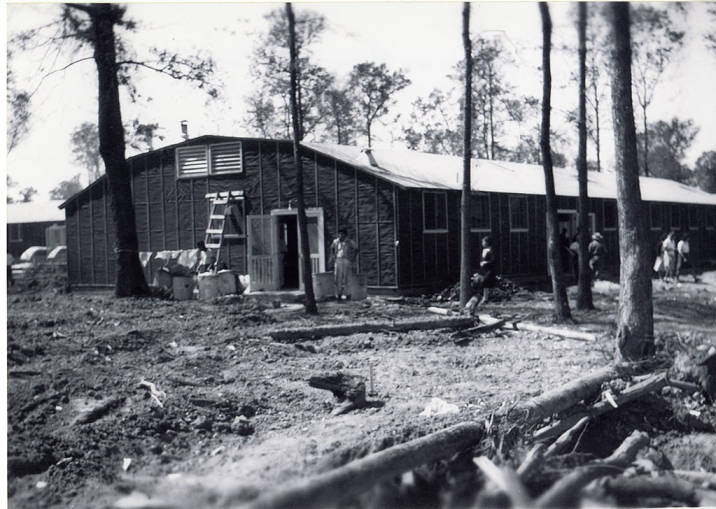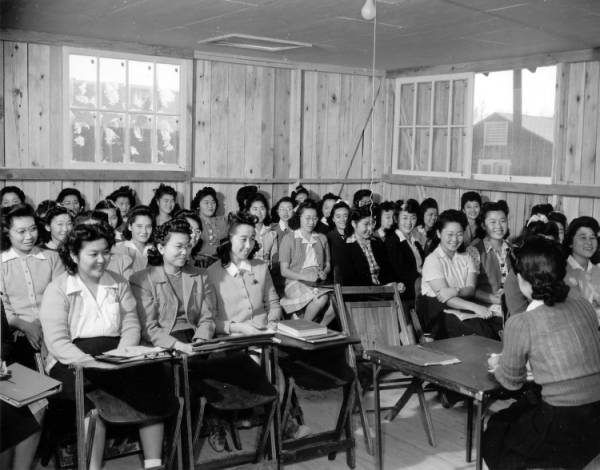Rohwer Relocation Center
The Rohwer Relocation Center in Desha County was one of two World War II-era incarceration camps built in the state to house Japanese Americans from the West Coast, the other being the Jerome Relocation Center (Chicot and Drew counties). The Rohwer relocation camp cemetery, the only part of the camp that remains, is now a National Historic Landmark. The camp housed, along with the Jerome camp, some 16,000 Japanese Americans from September 18, 1942, to November 30, 1945, and was one of the last of ten such camps nationwide to close. The Japanese American population, of which sixty-four percent were American citizens, had been forcibly removed from the West Coast of America under the doctrine of "military necessity" and incarcerated in ten relocation camps in California and various states west of the Mississippi River. This marked the largest influx of any racial or ethnic group in the state's history.

Rohwer Relocation Center under construction
UALR Center for Arkansas History and Culture
photographic print
c. 1942
Following the attack on Pearl Harbor on December 7, 1941, and America's subsequent entry into the war, many Americans feared an eventual invasion of the West Coast by the empire of Japan. Many people viewed the Japanese American population – eighty-nine percent of which lived in Washington, Oregon, and California – as potential spies and saboteurs. Citing the "doctrine of military necessity," President Franklin D. Roosevelt signed Executive Order 9066 on February 19, 1942, giving the secretary of war the power to designate military areas from which "any or all persons may be excluded" and authorizing military commanders to initiate orders they deemed advisable to enforce such action.
On March 18, 1942, Roosevelt signed Executive Order 9102, which created the War Relocation Authority (WRA) for the relocation, maintenance, and supervision of the Japanese American population. The search for sites for America's first Japanese "relocation centers," as they were euphemistically labeled by the WRA, was limited to federally owned lands located "a safe distance from strategic works," near railway lines for the easy transport of prisoners, and capable of adequately holding 5,000 to 8,000 people under supervision. By June 4, 1942, the WRA had selected ten sites, with the Arkansas camps being the easternmost of all those incarcerating the Japanese Americans.
The Arkansas sites, situated in the marshy delta of the Mississippi River's floodplain, were acquired with the assistance of Arkansas's Farm Security Administration (FSA) chief Eli B. Whitaker, having originally been tax-delinquent lands in dire need of clearing, leveling, and drainage. Survey descriptions of these lands indicate that Kelso Farms, an Arkansas corporation subject to a mortgage fee held by the federal government, owned 7,582 acres of the Rohwer site. Another 10,161 acres of land allotted to the Rohwer Center were located twelve miles northeast of McGehee (Desha County), of which 9,560 acres were obtained from the FSA.

Home economics class at Rohwer Relocation Center
UALR Center for Arkansas History and Culture
photographic print
c. 1942-1945
Construction on the Arkansas centers began in late July 1942 and extended into January of the next year, almost three full months after most Japanese had arrived. Under the guidance of the Army Corps of Engineers, major building contracts were let to the Linebarger-Senne Construction Company of Little Rock (Pulaski County). Construction cost for the Rohwer camp was $4,800,558. The Rohwer site eventually became 500 acres of tarpapered, A-framed buildings arranged into specifically numbered blocks. Each block was designed to accommodate around 300 people in ten to fourteen residential barracks, with each barrack (20' x 120') divided into four to six apartments for Japanese American families. Each block also consisted of a mess hall building, a recreational barrack, a laundry, and a communal latrine. The residential buildings were without plumbing or running water, and the buildings were heated during the winter months by wood or coal stoves. The camp also had an administrative section or block of buildings to handle camp operations, a military police section, a hospital section, a warehouse and factory section, a residential section of barracks for WRA personnel, barracks for schools, and auxiliary buildings for such things as canteens, motion pictures, gymnasiums, auditoriums, motor pools, and fire stations. The camp itself was surrounded by barbed wire or heavily wooded areas with guard towers situated at strategic areas and guarded by a small military contingent.
The internment camp was officially declared open but not completed on September 18, 1942, and would operate under the direction of Project Director Ray D. Johnston. Its peak population reached 8,475 people. Generational divisions of the Japanese American population are as follows: first-generation Japanese nationals were called Issei and were precluded from citizenship by federal immigration laws; second- and third-generation Japanese (Nisei and Sansei, respectively) were both American citizens by birth in the United States. American citizens of Japanese descent who had received some formal education in Japan were referred to as Kibei.

Rohwer Relocation Center Cemetery
UALR Center for Arkansas History and Culture
photograph
c. 1945
Accurate population and age statistics were constantly changing due to the forced movement of the Japanese populations. Well over ninety percent of the adult Rohwer population of 8,475 had been involved in agriculture, commercial fishing, or businesses that centered on the distribution of agricultural products. Thirty-five percent of the camp's population was Issei, ten percent of whom were over the age of sixty. Sixty-four percent were Nisei, with forty percent of those under the age of nineteen. There were 2,447 school-age children in the camp – a full twenty-eight percent of the total population.
Effective on October 1, 1942, the WRA initiated a new, comprehensive "leave" or "resettlement" program for the incarcerated Japanese Americans in the ten relocation centers, allowing some to live in relative freedom just outside the camp. All classifications of leaves were subject to specific conditions, guidelines, and security checks that could be denied or revoked at any time. The WRA's leave and resettlement program was met with limited success; each month, fewer than 100 young, college-bound or well-educated, security free, and socially accepted Japanese Americans at Rohwer were able to clear the elaborate process and earn the privilege to leave the camp.
Rohwer was the last of all the internment camps to close. The WRA had a difficult time relocating Japanese Americans back to their old homes and jobs in California. Following their occupants' removal, the buildings left behind were used for local schools and by farmers for a variety of purposes before falling into ruin. The Rohwer National Historic Landmark, added to the National Register of Historic Places on July 30, 1974, contains several monuments made by inmates during their internment, including one that honors Japanese American youth who died fighting for America in World War II; a small cemetery; and the remnants of the hospital smoke stack.
Source: Russell E. Bearden, "Rohwer Relocation Center," Encyclopedia of Arkansas History & Culture
.
